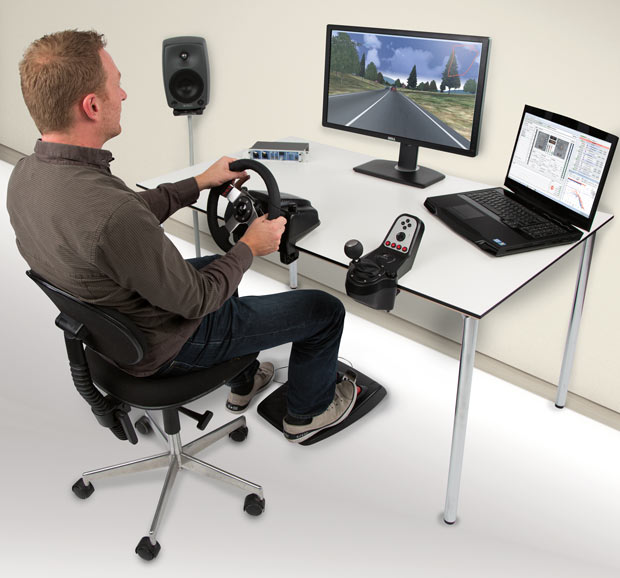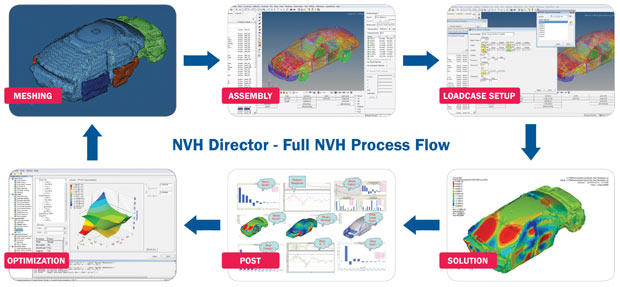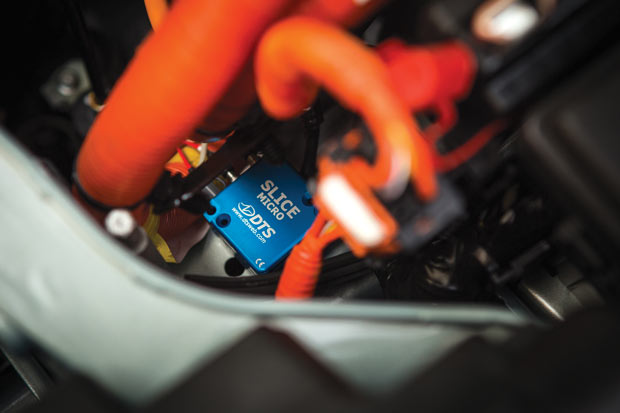
Brüel & Kjær’s NVH Simulator lets users view and hear their integrated test data through an automotive configuration. Image courtesy of Brüel & Kjær.
Latest News
June 1, 2016
 Brüel & Kjær’s NVH Simulator lets users view and hear their integrated test data through an automotive configuration. Image courtesy of Brüel & Kjær.
Brüel & Kjær’s NVH Simulator lets users view and hear their integrated test data through an automotive configuration. Image courtesy of Brüel & Kjær.If you own a car, you’re aware how noisy they can be. To properly maintain a vehicle, it’s important to listen for any odd sounds and investigate any vibrations that might indicate an issue. A good sound and feel are a mark of automotive quality, so engineers are constantly assessing noise, vibration and harshness (NVH) to ensure safety and an optimal consumer experience.
Engineers rely on a variety of technology to help them test for NVH, ranging from traditional data acquisition hardware to CAE-based simulators. With expanding options from a host of technology and service providers, more teams are able to test in an environment configured specifically for their needs.
“The application will typically define the hardware and software requirements for a NVH test. Normally, you cannot mix and match analysis software with data acquisition hardware. However, there are a few companies that do offer cross platform support. Most companies will normally adopt a vendor’s technology based on functionality, channel count, technical capabilities and of course the cost,” says Neil Coleman, president and CEO of Signalysis.
Getting Started
As with any testing workflow, engineers need to start with some sort of data, whether it’s in a CAE model or collected directly from the field. To help teams collect data, companies such as DTS offer data acquisition systems that can be used for in-field recording.
“In lab-based situations where size of the data acquisition system (DAS), power requirements and ruggedness are not required (such as in test cells) or bench top, just about any DAS on the market will do the job,” says Hans Hellsund, director, Sales and Marketing at Diversified Technical Systems (DTS).
Outside the lab, DAS requirements vary with the terrain. For its off-road applications, DTS offers SLICE MICRO, NANO and PRO systems. These devices are self-contained, portable and can work directly with sensors commonly used for NVH. “The primary differentiator of the SLICE systems [compared to the rest of the market] is that they are uniquely suited for situations where an embedded data recorder is desired or required because they are small, lightweight and non-obtrusive, and can be situated close to the sensor locations,” Hellsund notes.One company pairing software with new hardware advancements is the Siemens PLM Software LMS Test.Lab division. The organization recently debuted the LMS SCADAS XS, which makes NVH data acquisition more mobile, explains Scott MacDonald, senior applications engineer at Siemens PLM Software. “A big advancement for us was the mobile platform, where we can take those units out of the lab and put them in a vehicle, helicopter or airplane,” he says. “The XS [unit] takes mobility to the extreme, for literal ‘go anywhere’ testing.” Important features include extensive battery life and Wi-Fi tablet connectivity, which can add flexibility to in-field data collection.
Going Visual
In addition to using data collection hardware, engineers are now using CAE and additional simulation offerings to conduct NVH analyses. Advances in software and technology are upsetting the status quo of primarily using physical test systems during product development.
“With the gains in computational efficiency, an NVH analyst can also look at manufacturing variation, and conduct design space exploration and optimization studies to develop a fundamental understanding of the best architecture for the intended application, factoring in manufacturing processes, cost, weight, as well as performance factors such as durability and efficiency,” says Brian Wilson, president and CEO, Advanced Drivetrain & Engineering Technologies (ADET). “With this advancement in CAE efficiency, hardware testing can be conducted for verification purposes, and not for expensive development studies—or, at least limited development.”
Using simulation software also enables up-front engineering, notes Jianmin Guan, director of Vibrations and Acoustics Solutions at Altair. This is especially important when addressing product complexity, shorter design cycles to bring cars to market and working with engineers beyond the NVH department. Visually representing test data through simulation can help non-NVH engineers and product managers realize the significance of certain design changes that may not be conveyed through graphical data.
 Altair’s NVH Director draws on HyperWorks and OptiStruct capabilities to deliver a comprehensive simulation workflow. Image courtesy of Altair.
Altair’s NVH Director draws on HyperWorks and OptiStruct capabilities to deliver a comprehensive simulation workflow. Image courtesy of Altair.This emergence of using simulation for NVH has led to more immersive solutions such as Brüel & Kjær’s NVH simulator. The offering pairs sound testing with visuals on the desktop, on the road or in a CAVE-like environment. “The normal output is a graph or a set of numbers—some visual representation of the sound or vibration. As people, we don’t understand sound and vibration as numbers, we understand it by actually listening and feeling it,” says Dave Bogema, senior application engineer at Brüel & Kjær. “You really have to experience [sound] to understand what it means.”
The goal of this simulator, Bogema explains, is to help bridge the gap between the objective hard data and the real world. Adding context to the situation through a virtual environment can help engineers more effectively make decisions about noise levels. “When you drive a car, you don’t listen to [just] the wind noise. You listen to the whole car. That’s how people evaluate their environment. If you just had your wind noise generated and listen to that, it’s beneficial, but it’s nowhere near as beneficial as being able to mix that in with some road noise and powertrain noise and make it sound like a real car would,” he says.
The visual component may also shift how someone responds to a sound, Bogema notes. Oftentimes, he’s played road noise of 70 mph to people just through calibrated headphones, and they find it too loud. However, once he plays the noise on the NVH simulator with a screen, steering wheel and car pedals, the same 70 mph gets a positive response and isn’t as harsh to listeners.
Siemens is also giving additional context and visualization to NVH with its High Definition Acoustic Camera and 3D Acoustic Camera. If you have a noise you either like or don’t, these tools paint a hotspot of where that sound is coming from on a picture or digital model, says MacDonald. This ability to use sound source localization, he notes, can help save time and calculations. “[It’s a] visual companion to NVH data,” he says.
 The new High Definition Acoustic Camera can help engineers pinpoint hotspots for NVH generation. Image courtesy of Siemens PLM Software.
The new High Definition Acoustic Camera can help engineers pinpoint hotspots for NVH generation. Image courtesy of Siemens PLM Software.ESI Group is well established in the industry through its Virtual Performance Solution (VPS). This offering includes tools for NVH as an integrated module within its full portfolio to help address issues that appear later in the design process, says Williem van Hal, product manager of NVH, VPS. “[The VPS modules] share the same materials, boundary conditions and connectivity techniques, so what NVH needs from a structural standpoint is a subset of what is already there,” he says.
The module can combine porous elastic and finite element model data to help engineers make deeper and more accurate predictions on the functional behavior of the structure, according to van Hal. ESI’s VPS will also “reuse data that is already existing, saving [our customers] time on generating new models dedicated to NVH,” he says.
Also drawing on its established offerings, Altair released the NVH Director back in 2012. “The NVH Director is a tool created specifically for NVH simulation at a very high end, [meaning] full-vehicle simulation,” says Guan. “[Altair has] covered the entire flow of simulation from the beginning of modeling the CAD geometry to finding a better solution.” It’s an integrated offering, Guan explains, linking most of the products that Altair has, including HyperMesh, OptiStruct, HyperWorks, HyperStudy and HyperView.
This marks a recent commercial solution and also brings accessibility to NVH CAE, Guan adds. “In the past, full-vehicle simulation was closely held by OEMs (original equipment manufacturers). Each [company] would have their own way of validating NVH and it was done by the top OEMs. With the NVH Director, now every OEM has access to all the capabilities we’ve built into the software. It makes it much easier for them to catch up to best practices.”
Collaboration is Still Key
Even with many companies developing their own proprietary solutions for NVH analysis and testing, organizations are still finding ways to expand their networks and offer more extensive solutions to their customers.
To ensure its software offerings can support more simulation formats, Brüel & Kjær forms partnerships directly with CAE suppliers. “[These companies] are really excited that we can offer their customers a way to actually experience their data and we’re happy to help them do the same,” Bogema says. Current collaborations include MSC Software, Altair, Dassault Systèmes, Exa Corporation and Siemens PLM Software.
In addition to industry partnerships, engineering teams can also work with service providers to address their NVH testing and analysis needs. ADET continues to develop its network of industry experts for addressing multiple drivetrain design issues, Wilson states. “Often, a company may employ a drivetrain NVH expert, but this individual is normally skilled in either CAE or test, and quite often, is fully utilized and spread fairly thin. ADET has NVH experts available in both CAE and test, and can help address resource or skills issues,” he explains.
A New Standard?
With the emergence and development of a whole new set of NVH simulation tools that enable a more visual workflow, some may wonder if this means a future that isn’t dependent on lab-based testing. Most experts don’t see engineers abandoning traditional data acquisition systems and techniques any time soon. Instead, they believe the new NVH process will foster a hybrid of lab-derived data, simulation and virtual models.
“You need to verify that the assumptions made in the simulations are correct,” says DTS’ Hellsund. “The analysis results need to be compared with real-world experimental data until you are certain the simulation inputs are correct. If any design changes are made, this verification process needs to be repeated. They go hand in hand.”
 SLICE standalone data acquisition systems are designed for embedded applications with challenging space limitations and rugged test environments. Image courtesy of DTS.
SLICE standalone data acquisition systems are designed for embedded applications with challenging space limitations and rugged test environments. Image courtesy of DTS.“Test has always had a place to verify and understand how the models were working, so I think there’s always going to be a partnership between the two,” says MacDonald. “As we see computing technology and processing capability continue to grow, we will be able to at least attempt to simulate things that are just so much faster and easier to get with a test. But I think there are always going to be [unknown elements] that are only figured out through test. I never think it’ll be a one pony show.”
More Info
Subscribe to our FREE magazine, FREE email newsletters or both!
Latest News
About the Author
Jess Lulka is a former associate editor for Digital Engineering. Contact her via de-editors@digitaleng.news.
Follow DE




